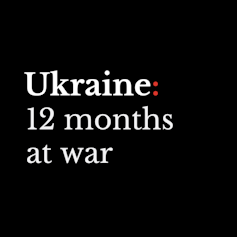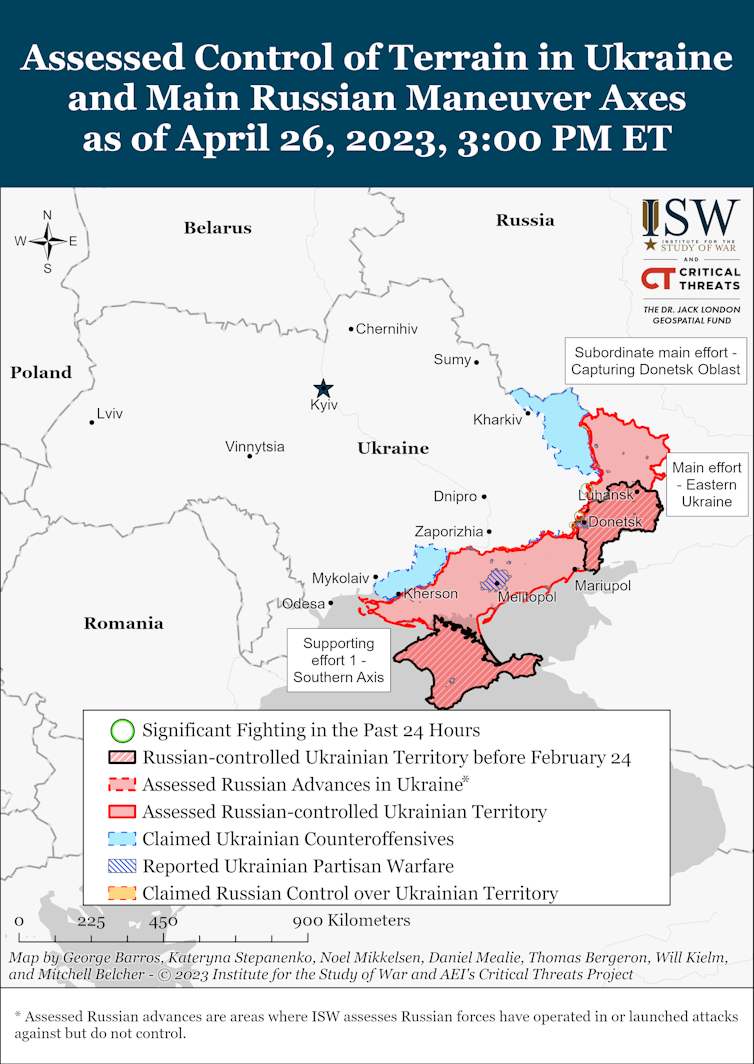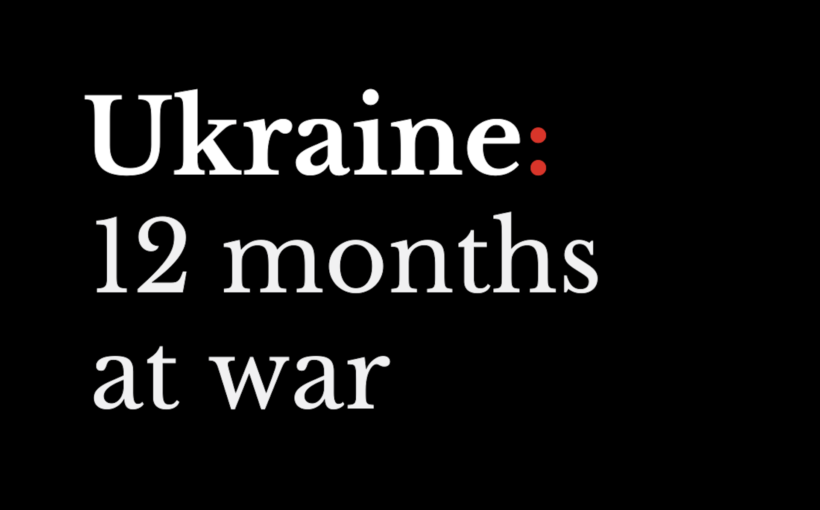A quick check of the Met office forecasts for Ukraine suggests that over the next week or so the weather is going to get steadily warmer. The rising mercury has fuelled speculation that Ukraine’s much discussed spring offensive is just around the corner, the only questions being when and where Ukraine’s military planners intend to make their big push. Kyiv is being understandably tight-lipped about this, surprise and deception – as Sun Tsu noted in the Art of War millenia ago – being key to military success.
Some observers have noted that Ukraine has achieved a bridgehead on the eastern side of the Dnipro River, which could foreshadow a major push southwards towards Crimea. The big question exercising most military experts is whether Ukraine has received sufficient new military equipment from its western allies to achieve the sort of spectacular successes it managed in September and October last year.
But there are signs of war fatigue setting in among some of Kyiv’s friends, while – as we noted in the last Ukraine recap – an increasing number of countries are opting to join China in urging Volodymyr Zelensky to the negotiating table. Just this week the Chinese president, Xi Jinping, held a telephone conversation with the Ukrainian president, the first time the pair has spoken since the war began. Zelensky said afterwards that he had told Xi that: “There can be no peace at the expense of territorial compromises.”

Since Vladimir Putin sent his war machine into Ukraine on February 24 2022, The Conversation has called upon some of the leading experts in international security, geopolitics and military tactics to help our readers understand the big issues. You can also subscribe to our fortnightly recap of expert analysis of the conflict in Ukraine.
But with much of Europe and the west suffering rising inflation and the prospect of continuing unstable energy prices, this may become an increasingly unpopular stance. Stefan Wolff, an expert in international security at the University of Birmingham, tracks Beijing’s growing influence in the diplomatic manoeuvring around Ukraine while noting widening divisions in the west.
There is, as Chris Morris – an expert in military strategy at the University of Portsmouth notes here – an element of Catch-22 about the situation. Kyiv’s allies want the spring offensive to demonstrate that Ukraine can achieve significant gains on the battlefield if they are to continue to pour billions of dollars’ worth of military equipment into the cause. Kyiv, meanwhile, needs billions of dollars’ of military equipment to achieve that success.

The problem, as Morris notes, is that the recent massive leak of US intelligence files included Pentagon assessments that Ukraine is unlikely to make the same massive gains as it achieved last autumn. A great deal is likely to hang on whether that assessment is accurate or whether, like last year, Ukraine’s tactical nous will surprise everyone once again, most crucially, of course, the Russians.
Read more: Ukraine war: as Kyiv prepares counteroffensive it needs to convince allies it is up for the fight
Many observers have linked the fighting – particularly over the winter around the battered city of Bakhmut in Ukraine’s east – to the first world war: the trenches, the high casualty numbers, the slow progress across territory. Christiaan Harinck, an expert in the history of war at Utrecht University, says that while much of this is undeniable, it would be foolish to jump to conclusions about what would appear to be the failure of Russia’s winter offensive.
Moscow’s political objectives, Harink warns, might be as much about involving the west in a lengthy and debilitating conflict. As he writes here: “It might be the case that in its current assessment of the situation, a stalemate in eastern Ukraine serves the Kremlin’s purpose.”
Read more: Ukraine war: why WWI comparisons can lead to underestimates of Russia’s strengths
The Russian front
If many western commentators are comparing the trench warfare in eastern Ukraine to the first world war, Putin and his propaganda machine have been insistent in drawing parallels with the “great patriotic war” in which Russia (with, admittedly, a modicum of help from the US, Britain and other countries) faced down the Nazi threat and achieved victory in Europe.
Russians celebrate Victory Day on May 9 (the UK celebrates the same thing on May 8, due to the time difference) and, particularly since Putin came to power, it’s become a huge thing. One of the centrepieces is the march of the Immortals Regiment in which thousands parade with pictures of loved ones who gave their lives in defence of the homeland.
But not this year. It was recently announced that for security reasons the celebrations would be scaled back (cancelled in cities deemed too close to the Ukraine border) and the march of the Immortals will not take place.
Dina Fainberg, an expert in modern history at City, University of London, tells the story of how Victory day become Russia’s biggest national celebration. As she notes, the decision has been greeted with derision by many in the west. One former US military commander tweeting that: “Nothing says you’re a grand strategist quite like not having enough soldiers and equipment to hold an annual parade.”
Fainburg thinks there could be another reason behind the decision. Imagine if thousands of people turned up to march carrying pictures of loved ones killed in Putin’s “special military operation”.
Read more: Ukraine war: Russia scales back May 9 Victory Day celebrations amid fear of popular protests
Victory Day become a tradition during Soviet times. Another less palatable feature of that era were the show trials by which Stalin rid himself of possible rivals and other thorns in his side. Preparing to be sentenced to 25 years for “treason”, journalist and activist Vladimir Kara-Murza recently drew a comparison between his treatment and 1930s-style Soviet “justice”.
But, as Stephen Hall – an expert in authoritarian regimes at the University of Bath – notes here, Putin has shown he has myriad ways of silencing troublesome voices in modern Russia.
Further afield (and on sea)
Anyone following the war in Ukraine will have heard of the Wagner Group, a mercenary army allegedly run by one of Putin’s closest allies, Yevgeny Prigozhin. Allegedly, because Prigozhin himself denies any knowledge of the Wagner Group. Whatever the truth of this, there is increasing evidence that Russian mercenaries are involved in several parts of Africa, including Sudan – where savage fighting is rapidly spreading across the whole country and threatens to descend into civil war (although the Wagner Group denies this).
Kristian Gustafson and a team of intelligence experts at Brunel, University of London, have taken a close look at reports of Russian involvement in conflicts across Africa.
Finally, it remains unclear who was behind the sabotage to the Nord Stream pipeline last year that held up supplies of gas into Europe, fuelling concerns about the vulnerability of vital undersea and maritime infrastructure. Now a documentary report from a consortium of Scandinavian broadcasters has investigated the movements of a Russian research vessel called Admiral Vladimirsky allegedly collecting data on windfarms, gas pipelines, power and internet cables in the North Sea.
Christian Bueger, a professor of international relations at the University of Copenhagen, once accompanied a Royal Navy reconnaissance vessel to the North Sea where part of its mission was to look out for Russian spy ships. He gives us his assessment of just how vulnerable this infrastructure is to hostile interference.
Ukraine Recap is available as a fortnightly email newsletter. Click here to get our recaps directly in your inbox.
![]()



